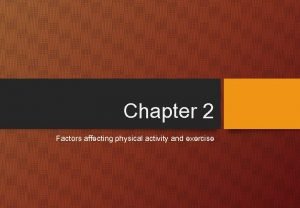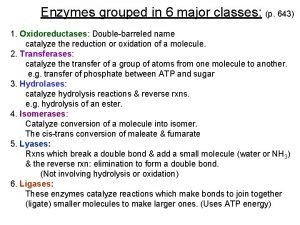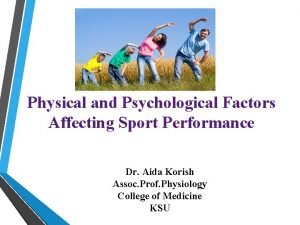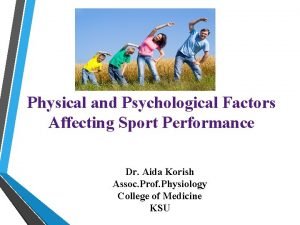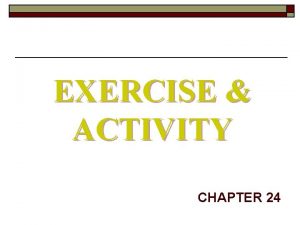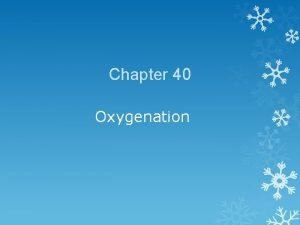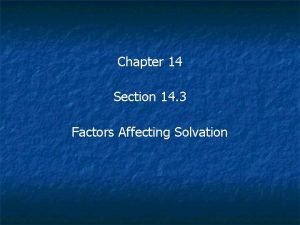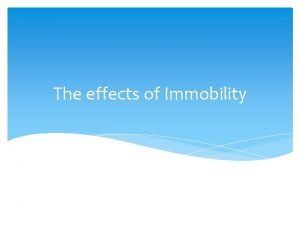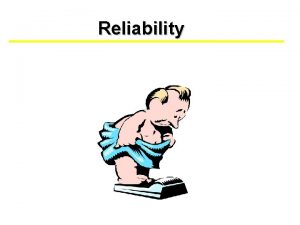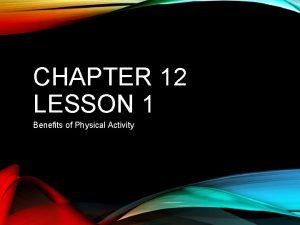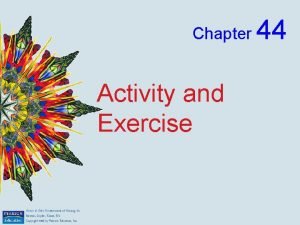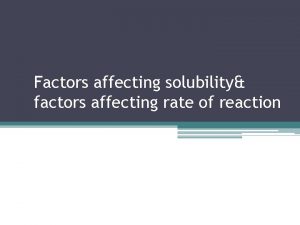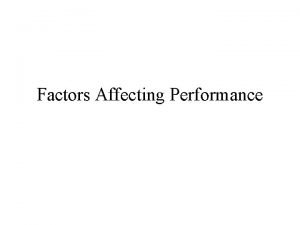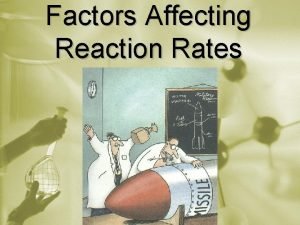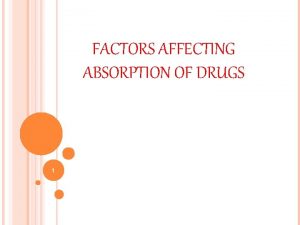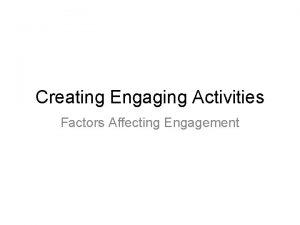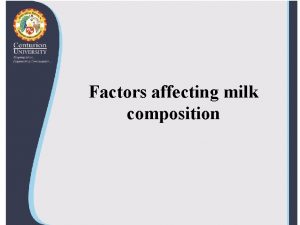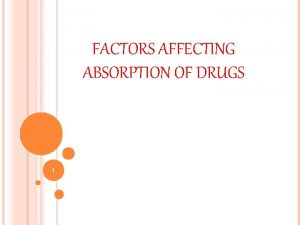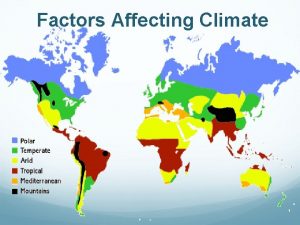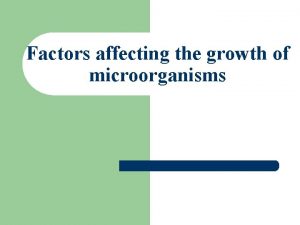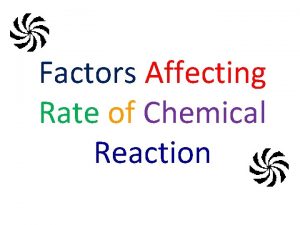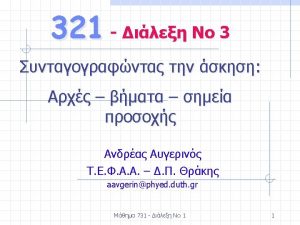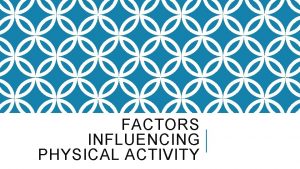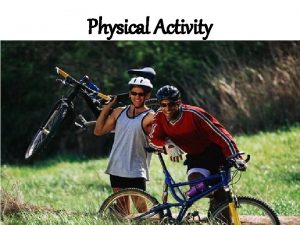Chapter 2 Factors affecting physical activity and exercise






















- Slides: 22

Chapter 2 Factors affecting physical activity and exercise

Factors affecting physical activity and exercise (Oliveira-Brochado, Oliveira. Brochado & Brito, 2010) • • • Demographic and biological Psychological, cognitive, and emotional Behavioral attributes and skills Social and cultural Physical environmental

Demographic and biological factors • • age ethnicity gender income socioeconomic status marital status race/ethnicity body mass index

Age • A person’s age and musculoskeletal and nervous system development affect their: • - posture • - body proportions • - body mass • - and body movements

Growth and Development (Kozier, Erb, Blais & Nilkinson, 1995) • Infants (1 year): Usually stands with legs slightly bowed and feet far apart. Balance is precarious. • Toddlers: Commonly uses arms for balance. • School-age children: Usually has excellent posture. • Adolescents : Posture is highly individual and determined to a large extent by the person’s selfimage. • Older adults: Deterioration of postural reflexes may require conscious widening of base of support to maintain balance.

Age • Almeida et al. (2005) found that as age increased, the number of participants decreased for most activities with the exception of walking and gardening. • Physical activity levels are the highest in childhood and decrease throughout adolescence and into adulthood (Katzmarzyk 2007).

Ethnicity • Ethnicity may play a role in explaining variation in physical activity levels. • Cultural practices and religious beliefs may affect one’s level of physical activity, and access to recreational resources may differ by ethnicity (Katzmarzyk, 2007)

Gender • Across the life span, males are more physically active than females, and they are more likely to participate in more vigorous forms of physical activity. (Katzmarzyk 2007) • There were more female participants for walking, keep fit, swimming and dancing, while football and other team sports had higher levels of participation among men compared with women. • Some barriers to physical activity differ among children and youths, middle-aged people, and older adults and between women and men (Godin et al. 1994).

Marital status • Some studies found that married people are more active than single people (Lee and Bhargava, 2004). • King et al. (1998) found that the transition from a single to a married state had a positive influence in physical activity, while, the transition from a married to a single state did not change physical activity behavior.

socioeconomic status • Socioeconomic status, income, occupation, and education were usually found to be positively related to physical activity participation (Trost et al. , 2002). • Almeida et al. (2005) found that there were more participants in most activities with increased education and Scheerder et al. (2006) concluded that a lower social class background serves as a barrier to involvement in sports and the type of leisure-time activity practiced varies in function of the subject’s social class. • Lera-López and Rapún. Gárate (2007) found a negative influence of some professional status categories on sport participation.

Body Mass Index (BMI) • Almeida et al. (2005) found that the association between daily physical activity and Body Mass Index (BMI) was not strong, but there is a tendency for overweight subjects to be those less involved in various activities.

Psychological, cognitive, and emotional factors • • • Attitudes barriers to exercise control over exercise enjoyment over exercise expected benefits health locus of control intention to exercise knowledge of health and exercise lack of time

Psychological, cognitive, and emotional factors • • • mood disturbance normative beliefs perceived health or fitness personality variables body image psychological health, self-efficacy self-motivation stage of change stress value of exercise outcomes

Psychological, cognitive, and emotional factors • Brownson et al. (2001) concluded that, among US adults, the most commonly reported personal barriers were lack of time, feeling too tired, obtaining enough exercise at one’s job, and no motivation to exercise. • Barriers to physical activity emerged as a strong influence on leisure time activity. • Lack of time was often perceived to be a barrier to physical activity (Humbert et al, 2006). • The factors cited as causing lack of participation in the exercises were mainly negative attitudes to exercise, low awareness level and lack of facilities. (Nambaka, J. E. , Kamau, J. , Amusa, L. O. , Goon, D. T. & Mwisukha,

Behavioural attributes and skills factors • • • activity history during childhood andyouth activity history during adulthood alcohol drinking habit contemporary exercise program dietary habits past exercise program process of change school sports skills for coping with barriers

Behavioural attributes and skills • Lifestyles characterized by certain types of consumption as drinking, smoking and excessive TV viewing may adversely affect physical activity levels as well (Sale, Guppy and El-Sayed, 2000). • Vries et al. (2008) found that behaviors as nonsmoking and physical activity are associated with each other and being a smoker was inversely related to physical activity in Germany. • A person’s lifestyles can affect physical activity and exercise.

Social and cultural factors • • class size exercise models group cohesion past family influence physical influence social isolation social support from friends and/or family members

Social and cultural factors • Social support from family, friends and peers on physical activity (Sallis et al. , 1987) • direct (such as exercising together or taking care of children so the spouse can exercise) • indirect (as encouraging a friend or family to be more active) • To promote physical activity, participation among youth must be addressed (Humbert et al, 2006)

Physical environmental factors • actual access to facilities • perceived access to facilities • adequate lighting • climate/season • cost of programs • disruptions in routine • enjoyable scenery • home equipment, high crime rates in the region • neighborhood safety • presence of sidewalks • satisfaction with facilities • urban location

Physical environmental factors • physical environments provides opportunities for physical activity, some examples include: • • - natural such as climate, weather, elevations and scenery - man made environments such as buildings, availability of facilities, runways, workplaces, homes, access, convenience, safety, and urban planning and design

Physical environmental factors • Influences on an individual level include exercise equipment at home, access to facilities, and satisfaction with recreation facilities • Influences on a community level include neighborhood safety, hilly terrain, frequent observation of others, engaging in physical activity and enjoying the scenery. (Brownson et al. , 2001; Santos et al. , 2008).

Conclusion • Factors that influence physical activity may be biologically determined, or may belong to the physical or social environment.
 Factors affecting physical activity
Factors affecting physical activity Factors affecting enzyme activity bbc bitesize
Factors affecting enzyme activity bbc bitesize 6 types of enzymes
6 types of enzymes Factors affecting movement in physical education
Factors affecting movement in physical education Factors affecting sports performance
Factors affecting sports performance Physiological factors affecting performance
Physiological factors affecting performance Physical fitness test grade 9
Physical fitness test grade 9 Chapter 24 exercise and activity
Chapter 24 exercise and activity Local and systemic factors affecting wound healing
Local and systemic factors affecting wound healing Factors affecting oxygenation in nursing
Factors affecting oxygenation in nursing Factors affecting width and intensity of spectral lines
Factors affecting width and intensity of spectral lines The factors affecting solvation and solvation energy are
The factors affecting solvation and solvation energy are Wages and salary administration
Wages and salary administration Factors affecting mobility and immobility
Factors affecting mobility and immobility Factors affecting reliability and validity
Factors affecting reliability and validity Chapter 12 physical activity and fitness
Chapter 12 physical activity and fitness A physical education chapter 12
A physical education chapter 12 Activity and exercise fundamentals of nursing
Activity and exercise fundamentals of nursing Activity and exercise pattern
Activity and exercise pattern Factors affecting their climate
Factors affecting their climate Factors affecting microbial growth in food
Factors affecting microbial growth in food Factor affecting volcanic eruption
Factor affecting volcanic eruption Factor affecting volcanic eruption
Factor affecting volcanic eruption
